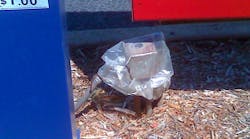How well do you know the Code? Think you can spot violations the original installer either ignored or couldn't identify? Here's your chance to moonlight as an electrical inspector and second-guess someone else's work from the safety of your living room or office. Can you identify the Code violation(s) in this photo?
Hint: Did the plastic bag just happen to magically blow its way here due to the wind, or was it placed here by someone for a specific reason?
Find the Answer
August Winners
Our three winners this month were: Michael S. Rhodes, E.I.T., associate engineer, Rogers-Schmidt Engineering Co., St. Louis; Gregory Mondragon, LEED AP, electrical engineer, Swanson Rink, Inc., Denver; and William Wilcox, project engineer, Electrical Systems, Affiliated Engineers, Inc., Gainesville, Fla. Here’s a list of the most noticeable Code violations these three associated with this bathroom/supply closet/electrical room installation.
• Sufficient access and working space shall be provided and maintained around all electrical equipment. Working spaces shall meet the requirements of 110.26(A)(1), (2), and (3). As noted in 110.26(B), items like mop buckets and ladders shall not be stored in these areas.
• Although we can’t confirm the ampere rating of the equipment in the electrical room, if it’s rated 1,200A or more then the access door needs to “open in the direction of egress and be equipped with panic bars, pressure plates, or other devices that are normally latched but open under simple pressure” per 110.26(C)(3). This door is clearing hinged to swing into the equipment room.
• As noted in 110.16, electrical equipment that is likely to require examination, adjustment, servicing, or maintenance while energized shall be field marked to warn of electrical arc flash hazards. The equipment also doesn’t appear to have any warning labels.
• If a second meter (look right above the existing meter) has been removed from the metering cabinet — and the opening has been left unprotected — then the requirements of 110.27 (guarding of live parts) have been violated.
‘TELL THEM WHAT THEY'VE WON…’
Using the 2008 NEC, correctly identify the Code violation(s) in this month's photo — in 200 words or less — and you could win something to put in your toolbox. E-mail your response to [email protected], and he'll select three winners (excluding manufacturers and prior winners) at random from the correct submissions. Winners will receive a set of insulated hand tools from Ideal Industries, Inc., valued at more than $125.* The set includes 9.25-in. insulated side-cutting pliers, 10-in. insulated tongue-and-groove pliers, and a 0.25-in. × 6-in. insulated screwdriver. (* Please allow six to eight weeks for delivery of tools.)



